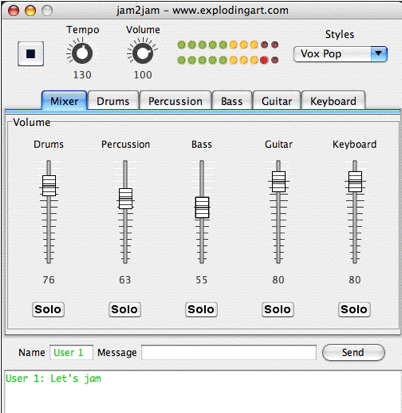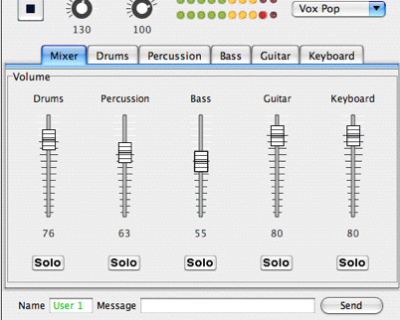Jam2jam applications generate music that you can control while it plays. Even better, you can connect via a network with your friends who have jam2jam to jointly control the music. Jam just like a band, but without the need for complex instrumental skills. Jam2jam was designed to promote meaningful music making with computers for musicians of all ages. The key to success is to take risks, be creative and listen to the sounds that your actions make. The first version of Jam2jam, the Gray version, was written in 2002 and (still) runs using the Java runtime on MacOS, Windows and Linux computers. Download it here.
Jam2jam was designed for collaboration. Connect jam2jam systems together to form a band where everyone controls each other’s parameters. Jam2jam systems can be connected over a local network for jamming in one location or you can connect over the internet for remote jamming; all in real-time. Latency effects are minimised because all music is algorithmically generated at each jam2jam site.
Jam2jam was designed to promote a meaningful engagement with music making with computers for musicians of all ages. The best approach is to experiment and listen to the sounds you make and participate in making great grooves either on your own or with others. The key to success is to take risks, be creative and listen to the sounds that your actions make. We hope you enjoy playing with it as much as we did making it.

Following the success of jam2jam gray with children in music festivals in the USA and Australia a series of other versions were created, many of which included video mixing as well as generative music jamming. Software development operated in parallel with research into music education and interaction design principles, the history of which is documented at jam2jam.com.
AV Jam

Based on the principles of jam2jam, AV-Jam is an application that generates music and video that you can control while it plays. The AV Jam software was originally written by Andrew Sorensen of MOSO corporation, and then maintained and developed by Andrew R. Brown and Craig Gibson.
It produces collaborative interactive artworks, enabling its users to jointly control the music and video using a network of control surfaces connected to a computer. The user is able to jam just like a musician, but without the need for complex instrumental skills. The AV-Jam system was designed to promote meaningful engagement with media art for people of all ages.
Clever algorithmic processes generate music and video that shape the result by adjusting parameters on the AV-Jam interface. The AV Jam system enables groups of people, often young people, to control generative music and video processes as a collaborative performance. The system is designed to encourage social engagement around create tasks and to introduce participants to important music and video processes and concepts by experiencing and controlling them.
The AV Jam system was exhibited at the Sydney Powerhouse Museum from early February to mid-March 2008 and was a great opportunity for ACID to undertake extended public trials of it’s technologies that are designed to facilitate collaboration around creative media performances.
The AV Jam system is built on adaptive media techniques and theories of meaningful engagement developed by ACID researchers. The research trials provide an opportunity to observe how effectively these techniques and theories work in practice. Networked jamming systems, such as AV-Jam, provide learning opportunities based on real-time improvisation. Such environments provide interaction as a public and enjoyable opportunity, accessible in the contemporary and familiar format of virtual and present collaborative learning spaces. The benefits of networked jamming are that it makes creative activities accessible and engaging. It embodies creative knowledge in an audio/visual environment allowing simultaneous reflective discussion or demonstration of musical understanding.
A networked jamming environment like that provided by AV Jam provides opportunities to develop creativity skills while taking into account technical and interpersonal skills relevant to experimental and interactive artworks in a prototype phase.
AV-Jam uses dynamic music technologies developed by the Creative Communities project of the Australasian CRC for Interaction Design (ACID).

